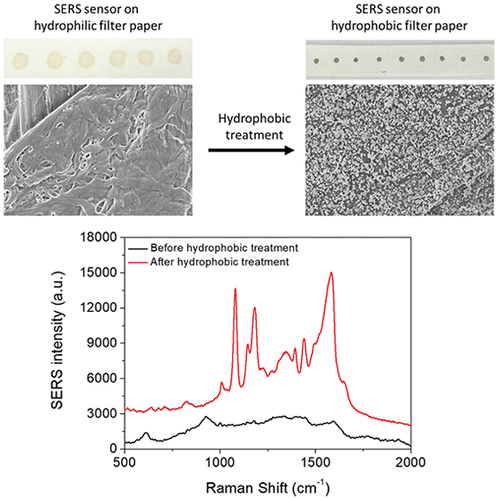Our official English website, www.x-mol.net, welcomes your
feedback! (Note: you will need to create a separate account there.)
Subnanomolar Sensitivity of Filter Paper-Based SERS Sensor for Pesticide Detection by Hydrophobicity Change of Paper Surface
ACS Sensors ( IF 8.2 ) Pub Date : 2018-01-12 00:00:00 , DOI: 10.1021/acssensors.7b00782 Minwoo Lee 1 , Kyudeok Oh 1 , Han-Kyu Choi 1 , Sung Gun Lee 1 , Hye Jung Youn 1 , Hak Lae Lee 1 , Dae Hong Jeong 1
ACS Sensors ( IF 8.2 ) Pub Date : 2018-01-12 00:00:00 , DOI: 10.1021/acssensors.7b00782 Minwoo Lee 1 , Kyudeok Oh 1 , Han-Kyu Choi 1 , Sung Gun Lee 1 , Hye Jung Youn 1 , Hak Lae Lee 1 , Dae Hong Jeong 1
Affiliation

|
As a cost-effective approach for detecting trace amounts of pesticides, filter paper-based SERS sensors have been the subject of intensive research. One of the hurdles to overcome is the difficulty of retaining nanoparticles on the surface of the paper because of the hydrophilic nature of the cellulose fibers in paper. This reduces the sensitivity and reproducibility of paper-based SERS sensors due to the low density of nanoparticles and short retention time of analytes on the paper surface. In this study, filter paper was treated with alkyl ketene dimer (AKD) to modify its property from hydrophilic to hydrophobic. AKD treatment increased the contact angle of the aqueous silver nanoparticle (AgNP) dispersion, which consequently increased the density of AgNPs. The retention time of the analyte was also increased by preventing its rapid absorption into the filter paper. The SERS signal was strongly enhanced by the increased number of SERS hot spots owing to the increased density of AgNPs on a small contact area of the filter surface. The reproducibility and sensitivity of the SERS signal were optimized by controlling the distribution of AgNPs on the surface of the filter paper by adjusting the concentration of the AgNP solution. Using this SERS sensor with a hydrophobicity-modified filter paper, the spot-to-spot variation of the SERS intensity of 25 spots of 4-aminothiophenol was 6.19%, and the limits of detection of thiram and ferbam as test pesticides were measured to be 0.46 nM and 0.49 nM, respectively. These proof-of-concept results indicate that this paper-based SERS sensor can serve for highly sensitive pesticide detection with low cost and easy fabrication.
中文翻译:

基于纸表面疏水性变化的基于滤纸的SERS传感器用于农药检测的亚纳摩尔灵敏度
作为检测痕量农药的一种经济有效的方法,基于滤纸的SERS传感器已成为深入研究的主题。要克服的障碍之一是由于纸中纤维素纤维的亲水性,难以将纳米颗粒保留在纸的表面上。由于纳米颗粒的低密度和分析物在纸表面的保留时间短,这降低了纸基SERS传感器的灵敏度和可重复性。在这项研究中,滤纸用烷基烯酮二聚体(AKD)处理,以将其性能从亲水性改变为疏水性。AKD处理增加了水银纳米颗粒(AgNP)分散液的接触角,因此增加了AgNPs的密度。通过防止分析物快速吸收到滤纸中,保留时间也增加了。由于在过滤器表面的较小接触区域上AgNP的密度增加,SERS热点数量的增加大大增强了SERS信号。通过调节AgNP溶液的浓度来控制AgNP在滤纸表面的分布,从而优化了SERS信号的重现性和灵敏度。使用带有疏水性滤纸的SERS传感器,在25个点的4-氨基苯硫酚的SERS强度的点到点变化为6.19%,测得的作为测试农药的呋喃和草胺的检出限为分别为0.46 nM和0.49 nM。
更新日期:2018-01-12
中文翻译:

基于纸表面疏水性变化的基于滤纸的SERS传感器用于农药检测的亚纳摩尔灵敏度
作为检测痕量农药的一种经济有效的方法,基于滤纸的SERS传感器已成为深入研究的主题。要克服的障碍之一是由于纸中纤维素纤维的亲水性,难以将纳米颗粒保留在纸的表面上。由于纳米颗粒的低密度和分析物在纸表面的保留时间短,这降低了纸基SERS传感器的灵敏度和可重复性。在这项研究中,滤纸用烷基烯酮二聚体(AKD)处理,以将其性能从亲水性改变为疏水性。AKD处理增加了水银纳米颗粒(AgNP)分散液的接触角,因此增加了AgNPs的密度。通过防止分析物快速吸收到滤纸中,保留时间也增加了。由于在过滤器表面的较小接触区域上AgNP的密度增加,SERS热点数量的增加大大增强了SERS信号。通过调节AgNP溶液的浓度来控制AgNP在滤纸表面的分布,从而优化了SERS信号的重现性和灵敏度。使用带有疏水性滤纸的SERS传感器,在25个点的4-氨基苯硫酚的SERS强度的点到点变化为6.19%,测得的作为测试农药的呋喃和草胺的检出限为分别为0.46 nM和0.49 nM。











































 京公网安备 11010802027423号
京公网安备 11010802027423号